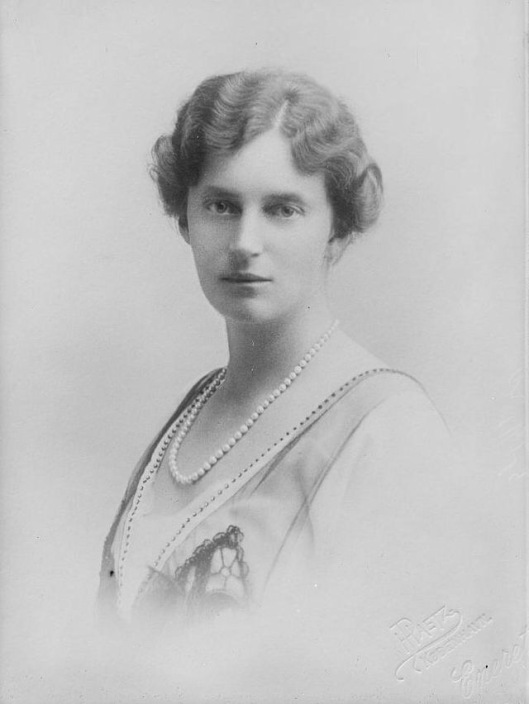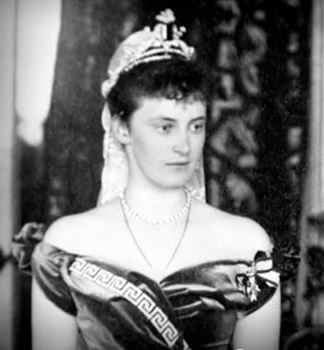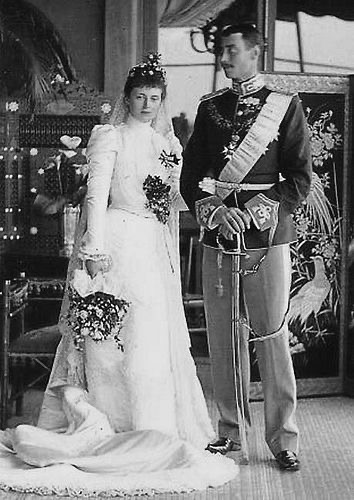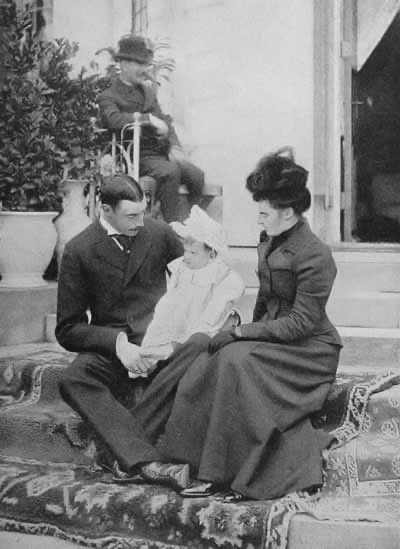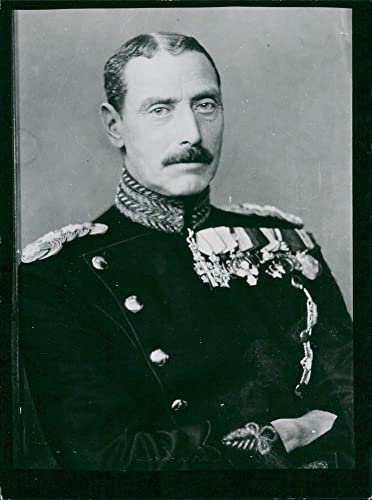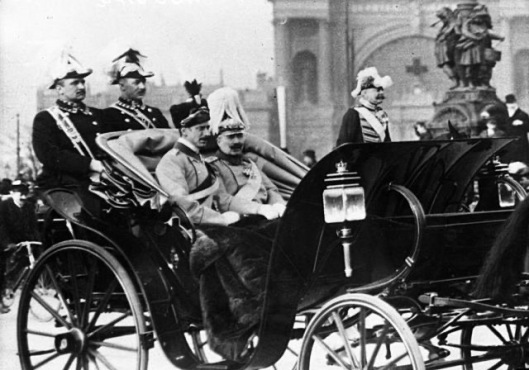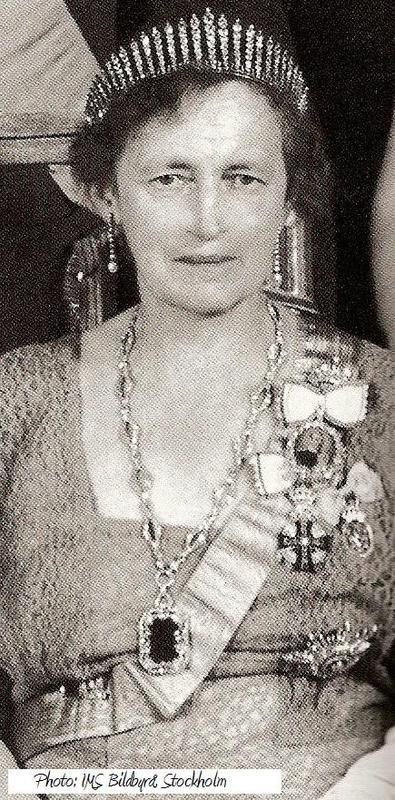Duchess Cecilie of Mecklenburg-Schwerin (Cecilie Auguste Marie; September 20, 1886 – May 6, 1954) was the last German and Prussian Crown Princess as the wife of German Crown Prince Wilhelm, the son of German Emperor Wilhelm II.

Duchess Cecilie of Mecklenburg-Schwerin, Crown Princess of Germany and Prussia.
Cecilie was a daughter of Friedrich-Franz III, Grand Duke of Mecklenburg-Schwerin and Grand Duchess Anastasia Mikhailovna of Russia, the only daughter and second child of Grand Duke Michael Nicolaievich of Russia and a granddaughter of Emperor Nicholas I of Russia. Emperor Nicholas I’s wife was Princess Charlotte of Prussia (1798–1860), the eldest surviving daughter of King Friedrich-Wilhelm III of Prussia (r. 1797–1840). Princess Charlotte of Prussia was a sister of Friedrich-Wilhelm IV and of Wilhelm I, German Emperor, the great-grandfather of Crown Prince Wilhelm. This means that Duchess Cecilie and her husband, Crown Prince Wilhelm, were 3rd cousins with King Friedrich-Wilhelm III of Prussia being their closest common ancestor.
Incidentally, Emperor Nicholas I of Russia and Princess Charlotte of Prussia were also 3rd cousins, as they were both great-great-grandchildren of Friedrich-Wilhelm I of Prussia.
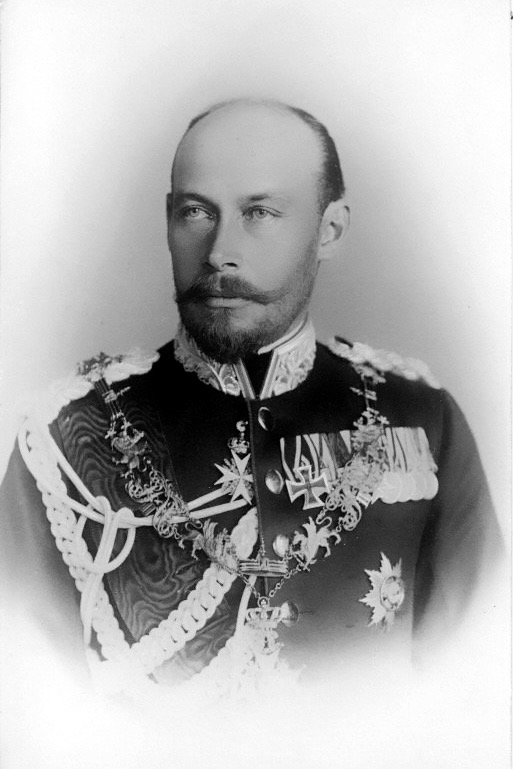
Duchess Cecilie’s father, Friedrich-Franz III, Grand Duke of Mecklenburg-Schwerin.
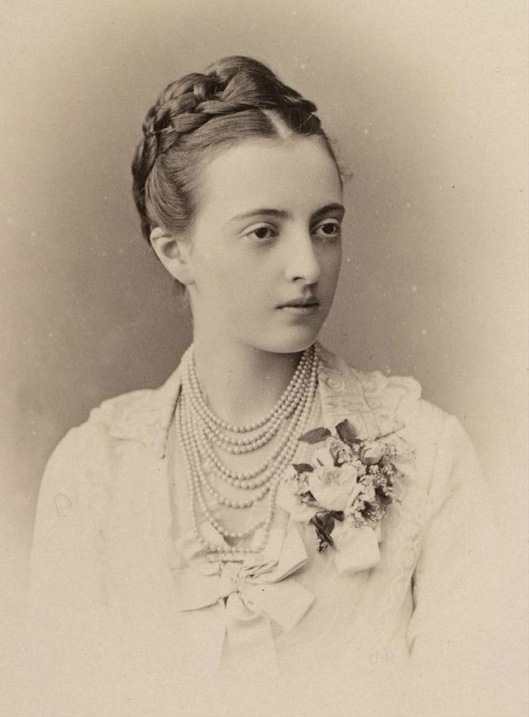
Duchess Cecilie’s mother, Grand Duchess Anastasia Mikhailovna of Russia
Duchess Cecilie was brought up with simplicity and her early life was peripatetic, although she spent most of her childhood in Schwerin, at the royal residences of Ludwigslust Palace and the Gelbensande hunting lodge, only a few kilometres from the Baltic Sea coast. Her father suffered badly from asthma and the wet damp cold climate of Mecklenburg was not good for his health. As a result, Cecilie spent a large amount of time with her family in Cannes in the south of France, favoured at the time by European royalty, including some whom Cecilie met such as Empress Eugénie and her future husband’s great-uncle, Edward VII.
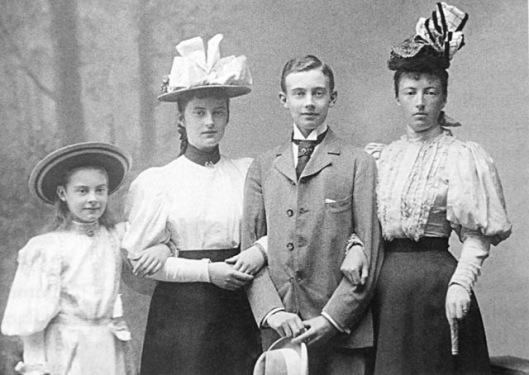
Cecilie, Alexandrine and Friedrich-Franz of Mecklenburg-Schwerin with their mother Grand Duchess Anastasia.
During the winter visit of 1897 to Denmark, Cecilie’s sister, Alexandrine, met her future husband, Crown Prince Christian, later Christian X of Denmark, shortly before the death of their father at the age of 46. After returning to Schwerin, Cecilie spent time with her widowed mother in Denmark. The wedding of her sister took place in Cannes in April 1898. After the death of her father, she traveled every summer, from 1898 to 1904, visiting her relatives in Russia. Cecilie lived there in Mikhailovskoe on Kronstadt Bay, the country home of her maternal grandfather, Grand Duke Michael Nikolaevich of Russia.

During the wedding festivities of her brother Friedrich-Franz IV, Grand Duke of Mecklenburg-Schwerin in Schwerin in June 1904, the 17-year-old Duchess Cecilie got to know her future husband, Wilhelm, German Crown Prince. Emperor Wilhelm II had sent his eldest son to the festivities as his personal representative. Taller than most women of her time at 182 centimetres (over 5’11”), Cecilie was as tall as the German Crown Prince. Wilhelm was struck by her great beauty, and her dark hair and eyes. On September 4, 1904, the young couple celebrated their engagement at the Mecklenburg-Schwerin hunting lodge, Gelbensande. The German Emperor had a wooden residence built nearby for the couple as an engagement present. On September 5, the first official photos of the couple were taken.

Official engagement photo of Crown Prince Wilhelm of Prussia and Duchess Cecilie of Mecklenburg-Schwerin.
Wedding
The wedding of Duchess Cecilie of Mecklenburg-Schwerin and the German Crown Prince Wilhelm took place on June 6, 1905 in Berlin. Arriving from Schwerin at Berlin’s Lehrter Station, the future Crown Princess was greeted on the platform with a gift of dark red roses. She was greeted at Bellevue Palace by the entire German Imperial Family and later made a joyeuse entrée through the Brandenburg Gate to a gun salute in the Tiergarten. Crowds lined the sides of the Unter den Linden as she passed on the way to the Berlin Royal Palace. Emperor Wilhelm II greeted her at the palace and conducted her to the Knight’s Hall where over fifty guests from different European royal houses awaited the young bride including Grand Duke Michael Alexandrovich of Russia, Archduke Franz Ferdinand, as well as representatives from Denmark, Italy, Belgium, Portugal and the Netherlands. On her wedding day, Emperor Wilhelm II presented his daughter-in-law with the Order of Louise.

The wedding ceremony took place in the Royal Chapel and also the nearby Berlin Cathedral. The royal couple received as wedding presents jewellery, silverware and porcelain. At the wish of the bride, Richard Wagner’s famous wedding march from Lohengrin was played along with music from The Meistersinger from Nuremberg conducted by Richard Strauss. On her wedding day, Duchess Cecilie of Mecklenburg-Schwerin became Her Imperial and Royal Highness The German Crown Princess and Crown Princess of Prussia. She was expected to one day become German Empress and Queen of Prussia. After the end of the wedding festivities, the German Crown Princely couple made their summer residence at the Marble Palace in Potsdam.

German Crown Princess
As German Crown Princess, Cecilie quickly became one of the most beloved members of the German Imperial House. She was known for her elegance and fashion consciousness. It was not long before her fashion style was copied by many women throughout the German Empire. Every year at the beginning of the court season in January, the couple would return to the Crown Prince Palace in Berlin on Unter den Linden. Cecilie’s first child was born on July 4, 1906 and given the traditional Hohenzollern name of Wilhelm.
At the time, the German monarchy appeared to be very secure. Nonetheless in private she had a fiery temper, not countenancing contradiction. Although in public the marriage of the Crown Prince and Princess appeared to be perfect, cracks quickly appeared due to the Crown Prince’s wandering eye and controlling behavior. Very early on, he began a series of affairs that strained the relationship between husband and wife – on one occasion announcing to his wife his latest escapade, whereupon she thought of drowning herself.
In spite of her husband’s unfaithfulness, however, Cecilie had given birth to six children by 1917.

She herself developed a passionate relationship with Baron Otto von Dungern (1873-1969), her husband’s aide de camp – attempting, once, to get into bed with Dungern. On discovering that Dungern was also having an affair with another woman at court, she confessed to her husband who told him to resign with the words: “Only my consideration for his imperial majesty (his father, Kaiser William II) prevents me from grinding you into the dust.”
World War I
At the time of the outbreak of war in 1914, Cecilie was once again pregnant. She was distressed when her first daughter, Princess Alexandrine, was born with Down’s syndrome. Due to the rigidity of Hohenzollern court protocol, the information about the condition was not released. As German Crown Princess, Cecilie was expected to carry on with her duties unaffected, which in time of war consisted largely of regular visits to the war wounded in an effort to sustain morale.
Cecilie’s husband the Crown Prince served on the western front in the south under the direct command of Field Marshal Hindenburg. In the last phase of the war, great difficulties affected the German people. For Cecilie, with strong family links to the Russian court through her mother, the Russian revolution of March 1917 greatly affected her. Her uncles, Grand Dukes Nicholas, George and Sergei Michailovich were all murdered.
Revolution and the overthrow of the German monarchy
The political and economic situation in the last year of the war became more and more hopeless. On November 6, 1918, the new German imperial Chancellor, Prince Max of Baden, met with Minister Wilhelm Solf to discuss the future of the German Empire. They were both of the opinion that the monarchy could only survive with the removal of the Emperor and his son the Crown Prince and the setting up of a Regentship under the nominal rule of the young son of Crown Princess Cecilie.
Such idea quickly disappeared with Friedrich Ebert becoming Chancellor and a republic being declared a few days later. Both the Emperor and the Crown Prince crossed the border to seek exile in neutral Netherlands. The monarchy collapsed with the defeat of Germany at the end of the war. Cecilie with her young children was living in Potsdam during the revolutionary period. She had moved from her new home of Cecilienhof with her children to join her mother-in-law in the relative safety of the New Palace. It was here that the Empress Auguste Viktoria informed her daughter-in-law, “The revolution has broken out. The Emperor has abdicated. The war is lost.”

Crown Prince and Princess Wilhelm and Cecile of Prussia visiting with Cecilie’s sister Alexandrine and her husband the future King Christian X of Denmark.
The former German Crown Princess was nothing but realistic about the new political situation confronting her family and Germany. The former Empress went into exile to join her husband. The Crown Princess was quite prepared to do the same, but wanted to stay in Germany with her children if at all possible. This she was allowed to do and on November 14, she quietly left the New Palace and returned to her private home Cecilienhof. As a result of a change of circumstances, Cecilie reduced her household staff by 50%.
Her children’s tutor also left her service and as a result her two eldest sons, Princes Wilhelm and Louis Ferdinand, for the first time attended as day students at a nearby school.Cecilie had considerable sympathy for the plight of the German people. In reply to an address from the German Women’s Union in Berlin, the former Crown Princess stated, “I need no sympathy. I have the beautiful situation that can befall any German woman, the education of my children as good German citizens.”
Crown Prince Wilhelm was only allowed to return to Germany from his enforced exile in 1923. Before then visits to him were difficult. Fortunately for the Hohenzollern family they still possessed considerable private holdings in Germany due to a provisional agreement worked out between the Hohenzollern family and the Prussian state in November 1920.
Castle Oels, a castle with 10,000 hectares of workable land in Silesia, now modern day Poland, provided substantial income for Cecilie’s family. In the absence of her husband, Cecilie became the leading figure in the once ruling House of Hohenzollern. The former Crown Princess was under no illusions that the empire would be restored, unlike her father-in-law exiled in Doorn in the Netherlands.
The Emperor’s return was completely impossible. With the election of Gustav Stresemann as Chancellor of the Weimar Republic in August 1923, negotiations for the former Crown Prince commenced. On the evening of November 13, 1923, Cecilie met her husband at Castle Oels. The years of separation and the behavior of Wilhelm had made the marriage now merely one in name only, but Cecilie was determined to keep things together even at a distance. More and more she lived in Cecilienhof at Potsdam, while her husband lived in Silesia.
The couple would come together when necessary for the sake of family unity for occasions such as family weddings, confirmation of children, christenings and funerals. In 1927, a final financial agreement was reached between the Hohenzollerns and the Prussian state. Cecilie remained active within several charity organizations such as the Queen Luise Fund, Chair of the Fatherland’s Women Union and the Ladies of the Order of St. John, while keeping clear of any political involvement. With the coming to power of the National Socialist Party of Adolf Hitler in 1933, all such charitable organizations were dissolved.
Under Nazi German rule 1933-1939
During 1933-1945, Cecilie lived a private life at Cecilienhof in Potsdam. Her eldest son, Prince Wilhelm forfeited his position as possible heir when he married Dorothea von Salviati on June 3, 1933. This occurred as she was not from a suitable royal family. Even though the royal house was formally deposed, its strict house rules still persisted.
The former Crown Prince and Princess were more understanding of their son than the exiled Emperor. Cecilie was not perturbed and made the best of the situation and was delighted when she became a grandmother for the first time on June 7, 1934. In 1935, Cecilie’s second son Prince Louis-Ferdinand worked, after studying economics and working for a time in the United States as a mechanic for Ford, with Lufthansa. Her third son, Hubertus, after spending a period of time farming joined the military and then the air force to become a pilot. The youngest son Friedrich went into business.

Prince Louis-Ferdinand of Prussia and his wife Grand Duchess Kira Kirillovna of Russia
In May 1938, at Cecilienhof, Prince Louis-Ferdinand married the Russian Grand Duchess Kira Kirillovna of Russia the second daughter of Grand Duke Kirill Vladimirovich of Russia (the pretender to the Russian throne) and Princess Victoria Melita of Edinburgh and Saxe-Coburg and Gotha, the third child and second daughter of Alfred, Duke of Saxe-Coburg and Gotha, and Grand Duchess Maria Alexandrovna of Russia. She was a granddaughter of Queen Victoria of the United Kingdom and Emperor Alexander II of Russia. This meant that Prince Louis-Ferdinand married the Russian Grand Duchess Kira we’re 2nd cousins once removed from their common descent from Queen Victoria of the United Kingdom. This wedding would be the last great family occasion before the outbreak of World War II in September 1939.
World War II
A period of relative calm for Cecilie’s family and for Germany came to an end with the outbreak of World War II in September 1939. Cecilie’s 24-year-old nephew, Prince Oskar, fell as a casualty five days after the start of the invasion of Poland. More personal tragedy occurred when her eldest son, Prince Wilhelm, was mortally wounded in battle at Valenciennes in France on 25 May 1940. He died on May 26, in a field hospital at Nivelle. His funeral took place in the Church of Peace at Potsdam on May 28, Over 50,000 people lined the way to his final resting place in the Antique Temple near the remains of his grandmother, former Empress Auguste Victoria. The huge turnout in respect for a Prince, who had died a hero’s death, from the former ruling dynasty, alarmed and infuriated Adolf Hitler. As a result, no Prince from a former German dynasty was allowed to serve at the front and in 1943 Hitler ordered that they all be discharged from the armed forces.

In 1941, the former German Emperor Wilhelm II died. At the age of 55, Cecilie’s husband became Head of the House of Hohenzollern. While under the monarchy this would have meant a great change for Cecilie and her husband. She would have been the new German Empress and Queen of Prussia and her husband would have become German Emperor and King of Prussia as Wilhelm III.
During this time, Cecilie and her husband increasingly retreated to Castle Oels to live a quiet life, far away from the dangers of Berlin. Even Potsdam, only 30 minutes away by train from the capital was too close for comfort. With the war going badly, Cecilie and her family left the advancing danger of the Soviet army to return to Potsdam where they celebrated Christmas in December 1944. It would be the last such occasion at her beloved home. In February 1945, Cecilie left Cecilienhof for the last time.
Final years
Cecilie fled the Red Army in February 1945 to the sanatorium of Dr. Paul Sotier (personal physician of Emperor Wilhelm II) Fürstenhof in Bad Kissingen in Bavaria. On 20 September 1946, she celebrated her 60th birthday. She was joined on this occasion by her husband and some of their children. Wilhelm had settled into a small house in Hechingen. Tragedy struck again when yet another son, this time Prince Hubertus, died from appendicitis on 8 April 1950. In early 1951, the health of the former Crown Prince deteriorated and on July 20, he died. On July 26, his funeral took place at Castle Hohenzollern where he was buried in the ground near an urn containing the ashes of the late Prince Hubertus. On the arm of her son, Prince Louis Ferdinand, Cecilie bade a final farewell to her husband. She remained in Bad Kissingen until 1952 when she moved to an apartment in the Frauenkopf district of Stuttgart.
In 1952, Cecilie’s memoirs, ‘Remembrances’ were published. In an act of healing and friendship, the former Crown Princess Cecilie was received by King George V of the United Kingdom’s widow, Queen Mary, in May 1952 during a visit to England. Cecilie visited for the first time to attend the christening of her granddaughter, Princess Victoria Marina of Prussia the daughter of her son Prince Frederick. Tragedy once again struck when Cecilie’s sister, the Danish Queen Mother, Queen Alexandrine died on December 28 of the same year. On January 3, 1953, Cecilie attended her funeral at Roskilde Cathedral in Denmark. From this time on, the former German Crown Princess never fully recovered. She managed to struggle on with the help of her family until May 1954 6, when she died on a visit to Bad Kissingen. It was the 72nd anniversary of the birth of her late husband. On May 12, 1954, her funeral took place and her remains were interred next to Crown Prince Wilhelm in the grounds of Castle Hohenzollern.
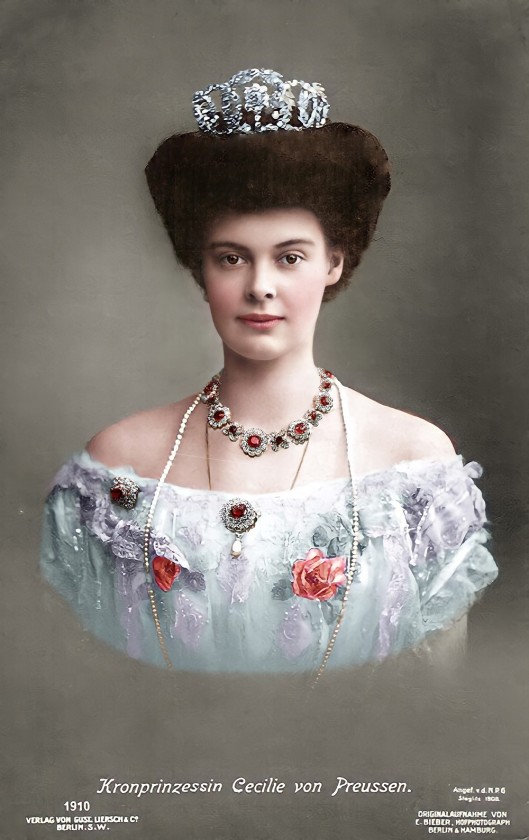
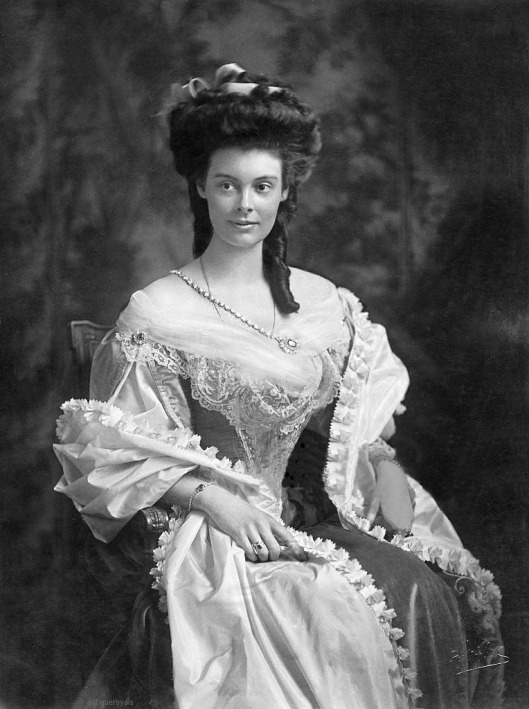
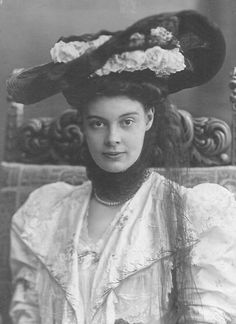
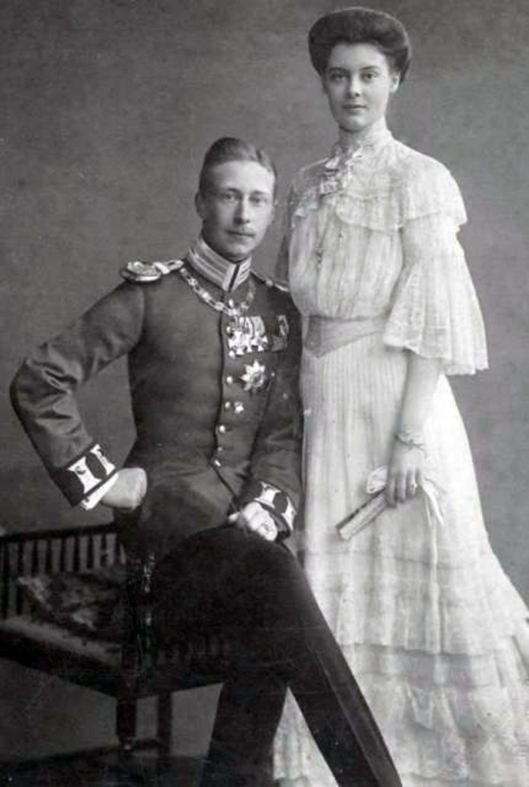
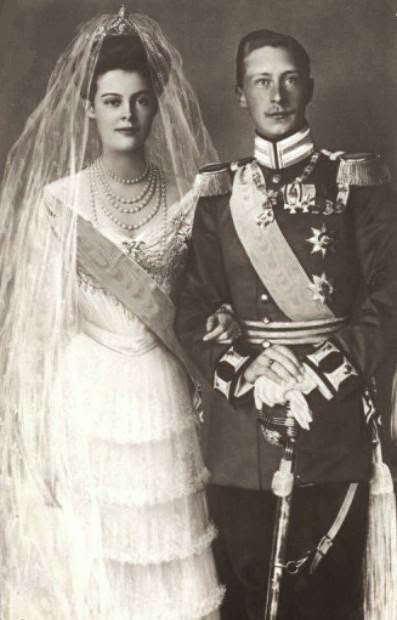
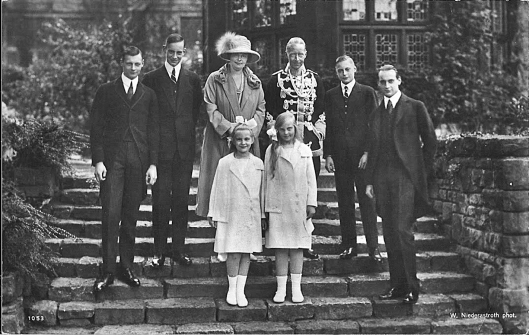
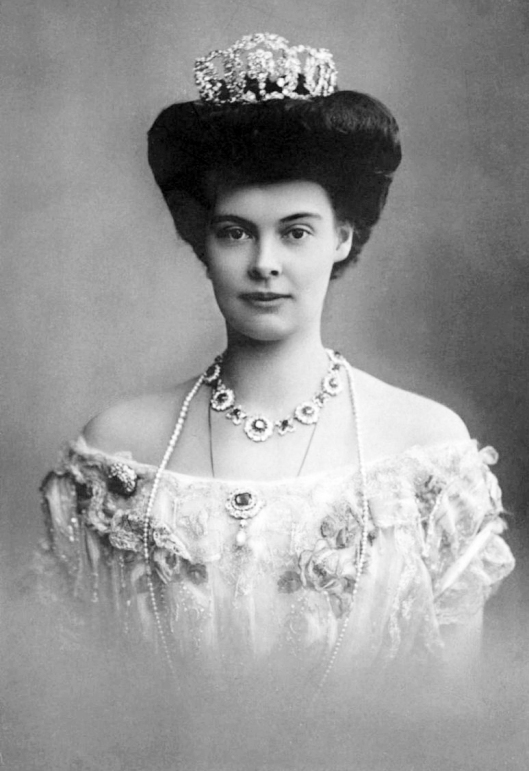









 .
.
